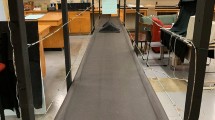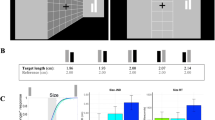Abstract
Biederman et al. [1, 2] have shown that the priming effect does not depend on the difference between the angular sizes of the test stimulus and the primer. However, these two and other similar studies investigated only a small range of the angular sizes of stimuli. Vakhrameeva et al. [3] have shown that there exist two perceptionally different size ranges: perception of the objects with an angular size varying between 1–1.5 and 50 degrees was found to be invariant, but for the objects whose angular size is less than 1–1.5 degrees, their perception is no longer invariant. In this study, the presence of the priming effect has been investigated in the match-to-sample task with such a difference in the angular sizes of the primer and test stimuli that the sizes of the primer (about 4 degrees) and the test stimulus (about 0.5 degrees) belonged to two different size ranges. The sample stimulus was presented with and without noise superposition. It has been shown that the priming effect is suppressed when the size difference between the primer and the test stimulus is large. A congruent primer can have a positive impact on the recognition of the test objects, but this occurs under the viewing conditions complicated by noise superposition.
Similar content being viewed by others
References
Biederman, I. and Cooper, E., Size invariance in visual object priming, J. Exp. Psychol., Hum. Percep. Perform., 1992, vol. 18, no. 1, p. 121.
Fiser, J., Biederman, I., and Bar, M., Invariance of long-term visual priming to scale, reflection, translation, and hemisphere, Vision Res., 2001, vol. 41, no. 2, p. 221.
Vakhrameeva, O.A., Shelepin, Yu.E., Mezentsev, A.Yu., and Pronin, S.V., Studies of the perception of incomplete outline images of different sizes, Neurosci. Behav. Physiol., 2009, vol. 39, no. 9, p. 841.
Kiefer, M., Morschett, A., Schonfeldt-Lecuona, C., et al., Altered time course of unconscious response priming in schizophrenia patients, Schizophr. Res., 2013, vol. 150, nos. 2–3, p. 590.
Jahshan, C., Wynn, J.K., Breitmeyer, B.G., and Green, M.F., Nonconscious and conscious color priming in schizophrenia, J. Psych. Res., 2012, vol. 46, no. 10, p. 1312.
Falikman, M.V. and Koifman, A.Ya., Types of priming in the researches of perception and perceptional consideration, Vestn. Mosk. Univ., Ser. 14: Psikhol., 2005, no. 3, p.86.
Agafonov, A.Yu. and Karpinskaya, V.Yu., Does the unconsciously hint help to solve the problem? The study of priming effects, Izv. Samar. Nauchn. Tsentra Ross. Akad. Nauk, 2010, vol. 12, no. 3, p. 1.
Kalinin, S.A., Gerasimenko, N.Yu., Slavutskaya, A.V., and Mikhailova, E.S., Behavioral and electrographical features of recognition of forward-masked complex images: The effect of categorical similarity of the target and masking stimuli, Hum. Physiol., 2014, vol. 40, no. 4, p. 355.
Kopeikina, E.A., Choroshich, V.V., Aleksandrov, A.Yu., and Ivanova, V.Yu., Effects of unconscious perception of acoustic stimuli on event-related potential parameters, Hum. Physiol., 2015, vol. 41, no. 3, p. 242.
Tsuchiya, N., Koch, C., Gilroy, L.A., and Blake, R., Depth of interocular suppression associated with continuous flash suppression, and binocular rivalry, J. Vision, 2006, vol. 6, no. 10, p. 1068.
Faivre, N. and Kouider, S., Multi-feature objects elicit nonconscious priming despite crowding, J. Vision, 2011, vol. 11, no. 2, p. 1.
Bondarko, V.M., Danilova, M.V., Solnushkin, S.D., and Chikhman, V.N., Estimation of the sizes of inhibitory areas in crowding effect in the periphery, Hum. Physiol., 2014, vol. 40, no. 3, p. 244.
Tsuchiya, N. and Koch, C., Continuous flash suppression reduces negative afterimages, Nat. Neurosci., 2005, vol. 8, no. 8, p. 1096.
Landry, M., Appourchaux, K., and Raz, A., Elucidating unconscious processing with instrumental hypnosis, Front. Psychol., 2014, vol. 5, p. 785.
Yang, E., Brascamp, J., Kang, M.-S., and Blake, R., On the use of continuous flash suppression for the study of visual processing outside of awareness, Front. Psychol., 2014, vol. 5, p. 724.
Dubois, J. and Faivre, N., Invisible,but how? The depth of unconscious processing as inferred from different suppression techniques, Front. Psychol., 2014, vol. 5, p. 1117.
Gayet, S., Van der Stigchel, S., and Paffen, C.L.E., Breaking continuous flash suppression: competing for consciousness on the presemantic battle field, Front. Psychol., 2014, vol. 5, Article 460.
Sterzer, P., Stein, T., Ludwig, K., Rothkirch, M., and Hesselmann, G., Neural processing of visual information under interocular suppression: a critical review, Front. Psychol., 2014, vol. 5, Article 453.
Faivre, N., Berthet, V., and Kouider, S., Sustained invisibility through crowding and continuous flash suppression: a comparative review, Front. Psychol., 2014, vol. 5, Article 475.
Faivre, N. and Kouider, S., Increased sensory evidence reverses nonconscious priming during crowding, J. Vision, 2011, vol. 11, no. 16, p. 1.
Barbot, A. and Kouider, S., Longer is not better: nonconscious overstimulation reverses priming influences under interocular suppression, Atten., Percept., Psychophys., 2012, vol. 74, no. 1, p. 174.
Dill, M. and Edelman, S., Imperfect invariance to object translation in the discrimination of complex shapes, Perception, 2001, vol. 30, no. 6, p. 707.
Dufau, S., GrainGer, J., and Holcomb, P.J., An ERP investigation of location invariance in masked repetition priming, Cognit., Affective Behav. Neurosci., 2008, vol. 8, no. 2, p. 222.
Eddy, M.D. and Holcomb, P.J., Electrophysiological evidence for size invariance in masked picture repetition priming, Brain Cognit., 2009, vol. 71, no. 3, p. 397.
Eddy, M.D. and Holcomb, P.J., Invariance to rotation in depth measured by masked repetition priming is dependent on prime duration, Brain Res., 2011, vol. 18, no. 1424, p. 38.
Farell, B. and Pelli, D.J., Can we attend to large and small at the same time?, Vision Res., 1993, vol. 33, no. 18, p. 2757.
Polyak, S., The Vertebrate Visual System, Chicago: Univ. of Chicago Press, 1957.
Wandell, B.A., Foundations of Vision, Sunderland: Sinauer Associates Inc., 1995.
Ivanishko, Yu.A., Nesterov, E.A., Miroshnikov, V.V., and Lotoshnikov, M.A., Topography of retina and pathological objects, Perv. Vseros. sem. Tez. dokl. i stenogrammy diskussii (First All-Russ. Seminar. Summaries of Reports and Transcripts of Discussions), Rostov-on-Don, 2004, p. 9.
Isik, L., Meyers, E.M., Leibo, J.Z., and Poggio, T., The dynamics of invariant object recognition in the human visual system, J. Neurophysiol., 2014, vol. 111, no. 1, p. 91.
Shelepin, Yu.E., Chikhman, V.N., Vakhrameeva, O.A., et al., Invariance in visual perception, Eksp. Psikhol., 2008, vol. 1, no. 1, p. 7.
Vakhrameeva, O.A., Sukhinin, M.V., Moiseenko, G.A., et al., The study of perception thresholds depending on the geometry of the fovea, Sens. Sist., 2013, vol. 27, no. 2, p. 122.
Krasil’nikov, N.N. and Shelepin, Yu.E., Masking as a result of mismatching filtration in the human visual system, Fiziol. Chel., 1996, vol. 22, no. 5, p. 99.
Polat, U., Mizobe, K., Pettet, M.W., et al., Collinear stimuli regulate visual responses depending on cell’s contrast threshold, Nature, 1998, vol. 391, no. 6667, p. 580.
Segaert, K., Weber, K., de Lange, F.P., et al. The suppression of repetition enhancement: a review of fMRI studies, Neuropsychologia, 2013, vol. 51, no. 1, p. 59.
Author information
Authors and Affiliations
Corresponding author
Additional information
Original Russian Text © O.A. Vakhrameeva, A.K. Harauzov, S.V. Pronin, E.Y. Malakhova, Y.E. Shelepin, 2016, published in Fiziologiya Cheloveka, 2016, Vol. 42, No. 5, pp. 39–48.
Rights and permissions
About this article
Cite this article
Vakhrameeva, O.A., Harauzov, A.K., Pronin, S.V. et al. Visual priming and perception of small pictures in a scene with multiscale objects. Hum Physiol 42, 499–507 (2016). https://doi.org/10.1134/S0362119716050182
Received:
Published:
Issue Date:
DOI: https://doi.org/10.1134/S0362119716050182




